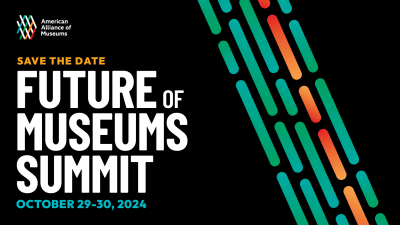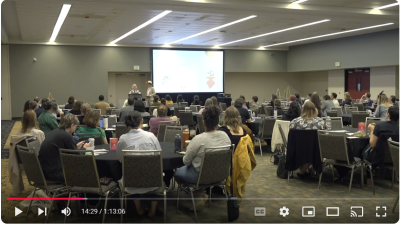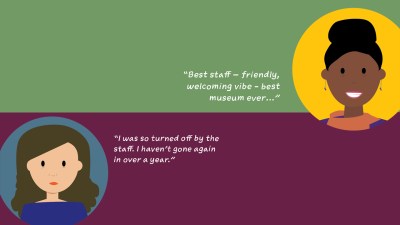
I am very happy to announce that the Alliance is recruiting an Assistant Director for the Center for the Future of Museums. I hope you will broadcast that news, and help us find the person who will be my deputy, collaborator, and partner-in-thought.
Why should you care?
CFM is the futures lab for the US museum sector (and on occasion, other country’s museums, and other nonprofit sectors in the US). That means that this person will be working on your behalf. Who do you want breaking trail for you and your organization? Who do you want at the other end of the digital line when you reach out for advice and assistance? What background, and perspectives, would enhance CFM’s ability to nurture better futures for museums and society?
Experiments with hiring
CFM is a think tank and idea lab for AAM, as well as the field, so any project (including hiring staff), is an opportunity to experiment with new practices. In this case, I’m leaning into two tactics:
One is radical transparency. Here is the ad for the position: that’s typically all a potential applicant has access to, in evaluating whether they are interested in a job. This post is the written equivalent of the conversation I’d have with a potential applicant if they popped by my office and said “hey, I’d like to hear more about this position. Let’s go for a walk and you can tell me all about it.”
Another is succession planning. While there are a lot of articles on succession planning, I’ve found precious few practical examples (at least, not examples shared in writing) from the museum sector. While there is no guarantee, I’m hoping whoever fills this position will take over the helm of CFM, when time comes for me to step down.
(You will see from the application instructions that AAM has adopted “blind hiring” practices piloted in an earlier CFM experiment.)
What the job entails
This may be a hard job to recruit for in part because there aren’t many accessible points of comparison. What does a museum futurist DO? And how will an assistant director contribute to that work?
Well, there will be a fair amount of routine procedural stuff: tracking financials, managing tasks and workflows, collecting forms and permissions from collaborators. But there is also considerable scope for creativity: writing content, researching trends, making public presentations, developing new projects.
Day to day and week to week, the work of the assistant director will involve:
- an enormous amount of curious investigation: searching for, reading, and digesting news, research, etc.
- reaching out to absolute strangers to make connections, learn about their work, sometimes to court their involvement in museum projects.
- lots and lots of writing: synthesis, analysis, in a friendly, accessible style.
- keeping track of lots of moving pieces: correspondence, leads, deadlines, goals and
- agility in the face of breaking news, and emerging challenges and opportunities. (To misquote Moltke, “no annual workplan survives contact with reality.”)
AAM is based in Crystal City, a “high octane urban community” in Arlington, VA. The position is hybrid, with staff currently expected to be in the office two days per week.
What kind of person might thrive in this work?
I suspect this could be a great position for someone:
- With omnivorous curiosity and imagination, balanced with a practical understanding of how to advance change.
- Able to get along with all sorts of people.
- Open and curious about a whole range of attitudes, opinions, feelings.
- Self-directed: thinking about how to make things better, different, not just waiting to be told what to do.
- Comfortable with public engagement: both informal networking and formal presentations. That doesn’t mean the ideal candidate has to be an extrovert (I myself am an introvert by inclination), but they do have to be able to muster the social energy needed for this work.
What kind of background will the successful candidate have?
I am agnostic on this point—I had fifteen years of experience working in museums, and eight at AAM, before learning foresight. That doesn’t mean that’s the only valuable approach to this work, and I hope candidates from other sectors, including people practicing foresight, will consider applying. I anticipate that whoever comes into this position will benefit from continuing education. If the successful candidate has no prior foresight training, they will be expected to take the University of Houston’s Certificate Course in Strategic Foresight (on AAM’s dime, of course). Conversely, someone with foresight experience may need a crash course in the world of museums. (I’m still working out what that training would look like—probably a combination of online workshops, and conferences.)
What I’m like as a boss
Sometimes it’s hard to see oneself accurately, and I invited some feedback from people I’ve supervised in the past. Overall, word is that I’m:
- Not a micro-manager: I typically present goals, deadlines, examples of how we’ve done it before (if relevant) and then leave people to take control. I tend to err on the side of giving people room to make their own mistakes (while trying to cushion the landing).
- Very animate about sharing my own thoughts and ideas. Working with me can be “a bit like working with Tigger,” (i.e., bouncy and enthusiastic), but I‘m also:
- A good listener, supportive of colleagues in their personal and work lives, who recognizes the good work and contributions of colleagues.
- A practitioner of “radical candor” when it comes to feedback, but I balance being direct with genuine care.
- Collaborative, liking to bounce ideas back and forth, and to co-create projects and products.
- A firm believer in work-life balance (really, I’ve put that in writing)
- A stickler when it comes to accurate representation of data. (That may seem like an odd thing to throw into this list, but I think it’s a core aspect of my personality.)
What it’s like working at AAM
I feel that the staff at AAM do a good job at living up to our Organizational Constitution (definitely read this if you are thinking of applying for the job). In particular, I appreciated my colleagues’ commitment to “celebrating our passion, joy, and creativity,” and “maintaining transparency, respect, and support for each other.” We strive to live up to the aspirations of our Constitution with conscious efforts by staff to more deeply center our humanity. The ideal candidate would be someone who is excited to contribute to that evolution
In our annual workplace survey, one thing that always stands out is how much staff enjoy working with each other. Not only because people are considerate and caring (they are), but because they are all so dang interesting. Seriously, check out the AAM staff list: fully half of my colleagues worked in museums before coming to the Alliance, and bring this love for our sector to the office. Others have an amazing panoply of experience, including working on Capitol Hill, in public broadcasting, higher education, and at AARP. They bring their passions as artists, athletes, cooks, travelers, parents, and pet-owners to work as well, and the Alliance is richer for it.
Not to say there are not challenges. When I first came to work at AAM, in 1999, we had over 70 (!) staff. Now we’re about half that size, while maintaining all our major programs (MAP, Accreditation, Advocacy, the Annual Meeting, Museum magazine). Sometimes we are stretched a little thin.
Another challenge is external—arising from people’s (mis)perceptions of AAM’s role and their expectations of our work. AAM can’t and doesn’t tell the field what to do. Those standards? Staff don’t make them up: our role is to support field-wide conversations about what museums can and should to, and capture and share the consensus. That’s actually an important point to make with regard to the role of CFM, and this position. We help museum people think about the future, imagine better futures, activate their power to make those futures—we don’t tell them what that future ought to be.
How to apply
Applications are due by March 18. You can find the job listing on AAM jobHQ, and login to apply online from there. Or,
- Submit a cover letter and resume to: hr@aam-us.org, using “Assistant Director” in the subject line. Please do not include your name or address on either document. Please include education but omit school names. Include your email address as the only personal identifier on these documents.
- As part of your cover letter:
- Provide an example of your work that demonstrates your ability to find, synthesize, and analyze information, and/or apply that analysis to thinking about the future. (Attachments or links welcome.)
- As AAM works to embed DEAI practices into all our programs, please share how your lived experience connects to or enhances your ability to contribute to AAM’s DEAI work.
- Explain why you are interested in this job.
- Limit your cover letter to no more than two pages.
Spread the word!
Please circulate news about this position through your networks. I would particularly value your bringing it to the attention of friends, co-workers, or colleagues you think might be interested, and a good fit.
I look forward to having our new Assistant Director of CFM introduce themselves to you, here on the blog, later this year.
Warmest regards from the future,

Skip over related stories to continue reading article









Comments